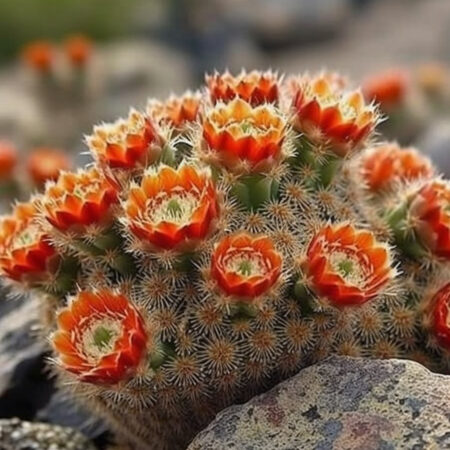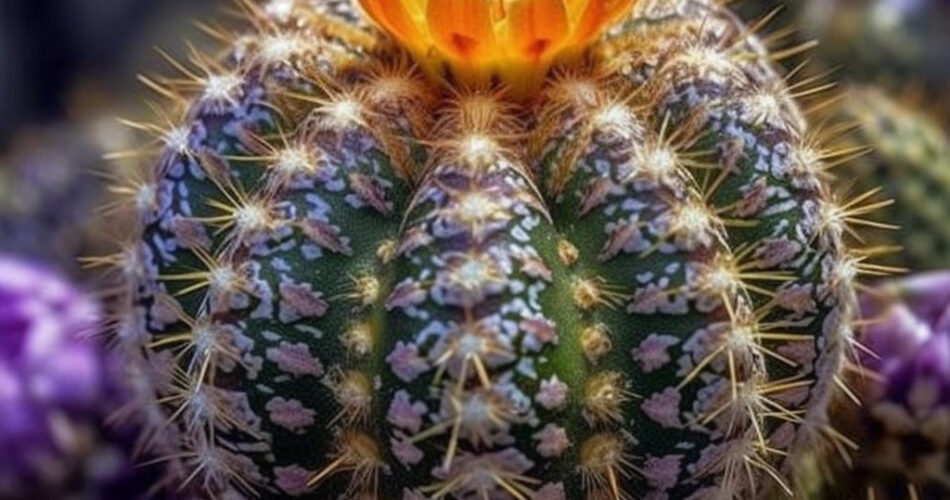Key Takeaways:
- It is a genus of cacti that is native to South America, known for its resilience in rocky terrains and harsh conditions.
- Has a mythical background and is associated with cultural and spiritual beliefs.
- It exhibits captivating colors and patterns, unique structures and forms, and fascinating adaptations in the wild.
- Cultivating it requires attention to its specific needs, including well-draining soil, proper watering, adequate sunlight, and balanced fertilization.
- This cactus can be propagated from seeds or offshoots, but it is a slow-growing cactus.
- Common challenges for Aylostera owners include pest infestations, fungal problems, and growth or flowering issues.
1. The Intriguing Origins of Aylostera
Aylostera is a genus of cacti that belongs to the family Cactaceae. With its captivating beauty and unique characteristics, Aylostera has become a popular choice among cactus enthusiasts. In this section, we will explore the origins of Aylostera and its rich history.
1.1 The Rich History and Geological Significance
Aylostera is native to the mountainous regions of South America, particularly Argentina and Bolivia. These areas are known for their diverse and unique ecosystems, and it has adapted to thrive in the harsh conditions found in these environments.
The geological significance of Aylostera lies in its ability to survive and flourish in rocky terrains with limited resources. Its strong roots penetrate the soil, allowing it to withstand droughts and periods of extreme temperatures. This resilience has made these cactuses an important plants in these regions.
1.2 Unveiling the Mythical Origins of Aylostera: Legends and Folklore
It has a fascinating mythical background that adds to its allure. According to local legends and folklore, Aylostera was believed to be a plant with magical properties. It was said to bring good luck, protect against evil spirits, and even possess healing powers.
These stories have been passed down through generations and have contributed to the cultural significance of Aylostera. Today, many people still associate Aylostera with these mythical beliefs and incorporate it into their spiritual practices.
1.3 Symbol of Resilience: Cultural and Spiritual Significance
This cactus ability to survive in harsh conditions has made it a symbol of resilience in many cultures. It represents the strength to overcome adversity and thrive against all odds. This symbolism has led to Aylostera being used in various cultural ceremonies and rituals.
From a spiritual perspective, Aylostera is believed to have the power to cleanse and purify energy. It is often used in meditation and healing practices to bring balance and harmony. The presence of Aylostera is said to promote feelings of peace and tranquility.
2. Unveiling the Enchanting Features of Aylostera
Aylostera is known for its enchanting features that make it a standout among other cacti. In this section, we will delve into these features and explore what sets Aylostera apart.
2.1 The Captivating Colors and Patterns
This cactus displays a wide range of colors and patterns that make it a visual delight. From bright pinks and purples to vibrant oranges and yellows, Aylostera showcases nature’s palette in a stunning array of hues. These colors often change and intensify depending on environmental conditions, adding to the intrigue.
The patterns found on Aylostera range from intricate swirls to distinctive geometric shapes. These patterns not only enhance its visual appeal but also serve as a defense mechanism. They help Aylostera blend into its natural surroundings, making it less visible to potential threats.
2.2 Understanding the Unique Structures and Forms
Aylostera exhibits a variety of growth habits and structures that contribute to its unique appearance. Some species of Aylostera have a solitary, globular shape, while others form clumps or dense mats. These variations add visual interest and allow for creative landscaping possibilities.
One of Aylostera’s most distinctive features is its areoles. These small, woolly structures are where spines, flowers, and new growth emerge. The size, shape, and color of the areoles differ among Aylostera species, making each one truly unique.
2.3 Discovering the Fascinating Adaptations of Aylostera in the Wild
This cactus has developed remarkable adaptations to survive in its natural habitat. One notable adaptation is its ability to store water in its thick, fleshy stems. This allows Aylostera to endure long periods of drought and make efficient use of available moisture.
Another intriguing adaptation of Aylostera is its specialized spines. These spines not only provide protection against herbivores but also help to reduce water loss by creating a barrier that minimizes transpiration. Some of the cactus species even have spines that change color based on light conditions, helping to regulate temperature.

3. The Art of Cultivating Aylostera: Proven Tips and Techniques
Cultivating it can be a rewarding experience, but it requires careful attention to its specific needs. In this section, we will explore the essential aspects of successfully growing and caring for this cactus.
3.1 Choosing the Ideal Growing Environment
One of the cactuses that thrives in well-draining soil that mimics its natural habitat. A mixture of sand, perlite, and cactus potting mix is generally recommended. It is important to provide sufficient airflow and avoid overwatering, as this can lead to root rot.
In terms of temperature, Aylostera prefers a warm and dry climate. It can tolerate a wide range of temperatures, but extremes should be avoided. Providing adequate sunlight is also crucial for optimal growth and flowering.
3.2 Essential Watering, Feeding, and Light Requirements
Watering it requires a delicate balance. It is important to water thoroughly but allow the soil to dry out between waterings to prevent waterlogged conditions. During the growing season, regular light feedings with a balanced cactus fertilizer can help promote healthy growth.
When it comes to light requirements, this cacti thrives in bright, indirect sunlight. A south-facing window or a well-lit spot in a greenhouse is ideal. However, care should be taken to prevent sunburn, especially during hot summer months.
3.3 The Propagation Secrets: Growing Aylostera from Seeds and Offshoots
Propagation of this cactus can be achieved through both seeds and offshoots. When using seeds, it is important to provide the optimal germination conditions, including a well-draining seed-starting mix and consistent moisture. Offshoots, or “pups,” can be carefully removed from the parent plant and replanted in a separate container.
It is worth noting that Aylostera is a slow-growing cactus, and patience is required when propagating and cultivating new plants. However, the reward of seeing your Aylostera thrive and blossom is well worth the wait.
4. Overcoming Challenges: Common Issues and Remedies for Aylostera
Like any plant, Aylostera can face challenges and health issues. In this section, we will explore some common problems that Aylostera owners may encounter and provide remedies to overcome them.
4.1 Identifying and Managing Pest Infestations
It is generally resilient to pests. However, it can occasionally fall victim to common cactus pests such as mealybugs and scale insects. Regular inspection and early detection are key to preventing infestations. In case of an infestation, organic insecticides or manual removal can help control the pests.
4.2 Dealing with Common Disease and Fungal Problems
Aylostera is susceptible to fungal diseases such as root rot and stem rot. These diseases are often caused by overwatering or poor soil drainage. To prevent these issues, it is important to provide proper drainage, avoid overwatering, and ensure good airflow around the plants.
4.3 Troubleshooting Growth and Flowering Issues
If Aylostera is not experiencing healthy growth or flowering, there may be several factors at play. Insufficient sunlight, improper watering, or nutrient deficiencies could be the culprits. Adjusting these conditions and providing the necessary care can help address these issues and encourage healthy growth and blooming.
FAQ
Question: What is Aylostera?
It is a genus of cacti native to South America known for its resilience in rocky terrains and harsh conditions.
Question: How does it differ from other cactus plants?
It stands out with its captivating colors and patterns, unique structures and forms, and fascinating adaptations in the wild.
Question: How can I cultivate it?
Cultivating it requires attention to specific needs, including well-draining soil, proper watering, adequate sunlight, and balanced fertilization.
Question: How can this cactus be propagated?
It can be propagated from seeds or offshoots, but it is a slow-growing cactus.
Question: What are the common challenges for Aylostera owners?
Common challenges for its owners include pest infestations, fungal problems, and growth or flowering issues.
Question: How can I prevent and manage pest infestations ?
Regular inspection, early detection, organic insecticides, and manual removal can help prevent and manage pest infestations.
Question: How can I prevent and manage disease and fungal problems in Aylostera?
To prevent disease and fungal problems in Aylostera, provide proper drainage, avoid overwatering, and ensure good airflow around the plants.
Question: What can I do to troubleshoot growth and flowering issues in Aylostera?
Adjusting sunlight exposure, watering practices, and addressing any nutrient deficiencies can help troubleshoot growth and flowering issues in Aylostera.
Useful Resources:
- Cactus and Succulent Society of America
- World of Succulents
- Royal Horticultural Society
- DesertUSA
- Gardening Know How
- Cactus and Succulent Plants
- Cactus Conservation Institute
- Cactus Pro




Comments